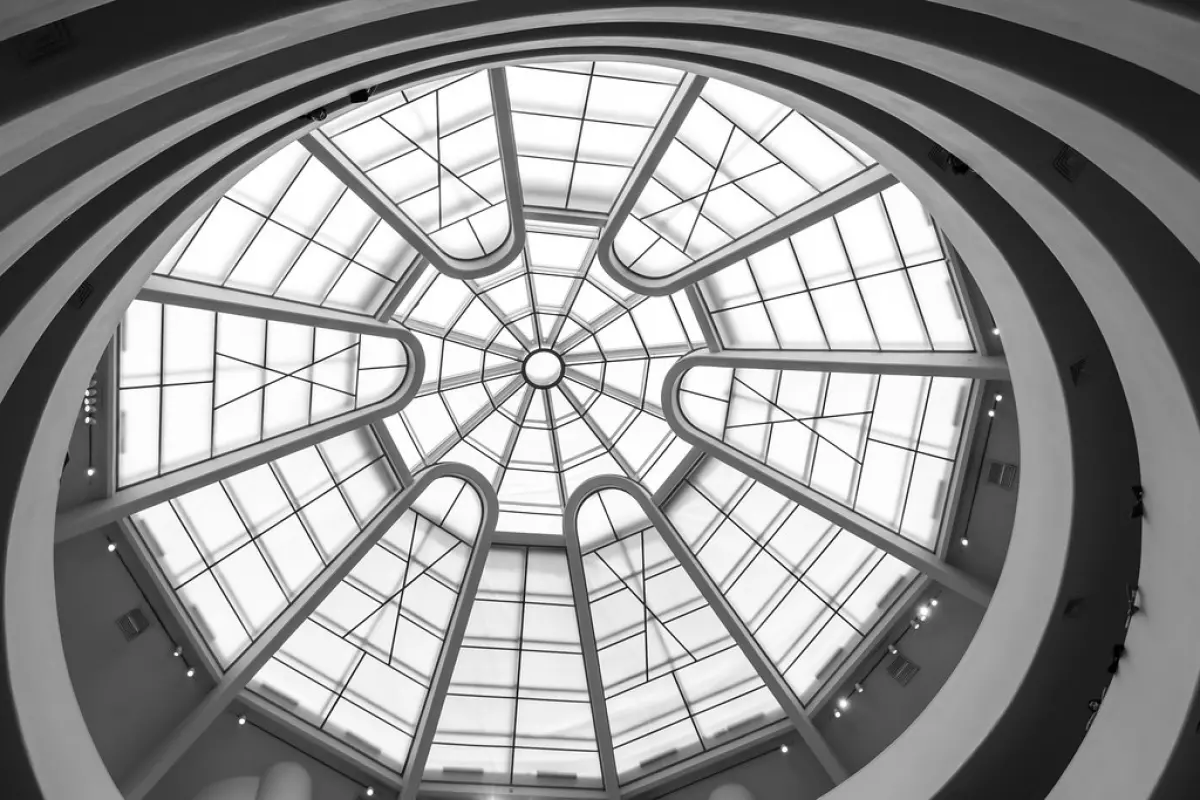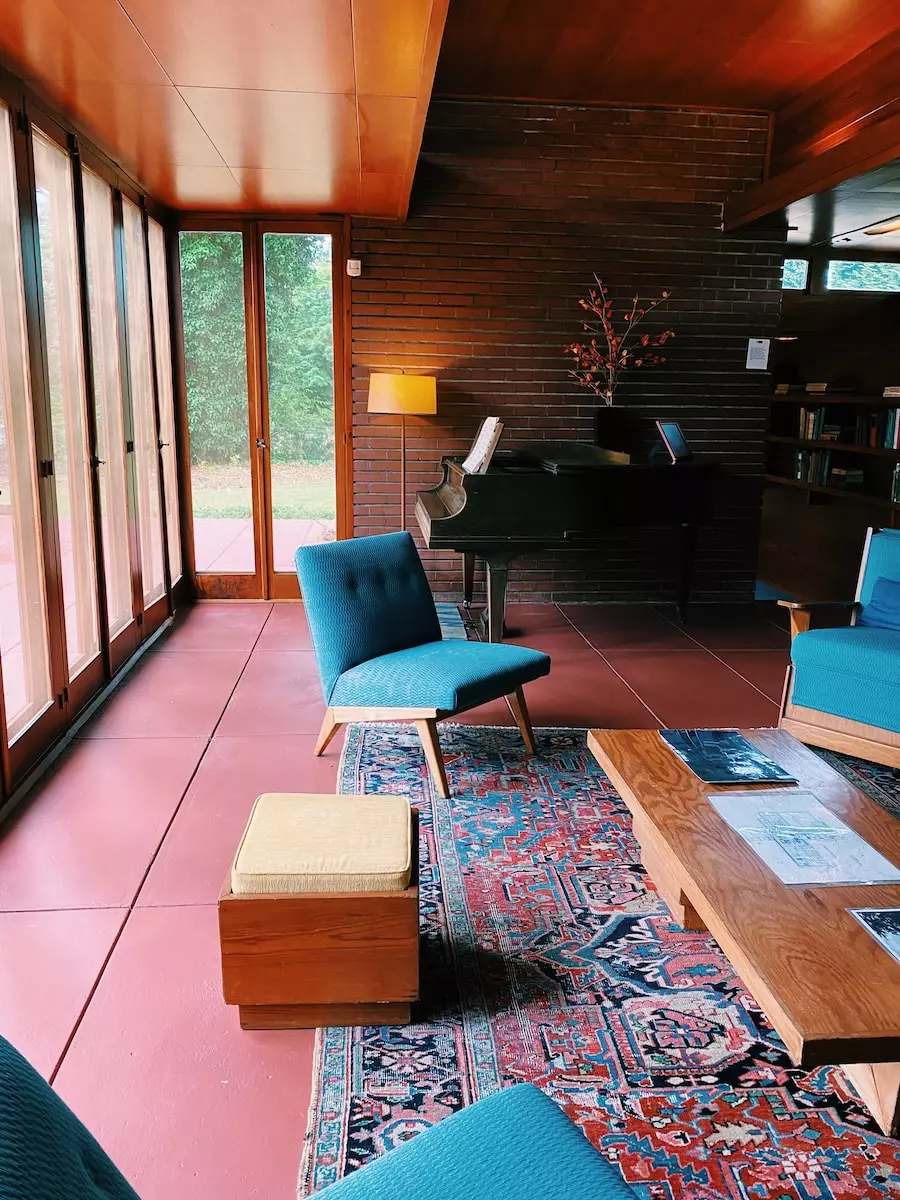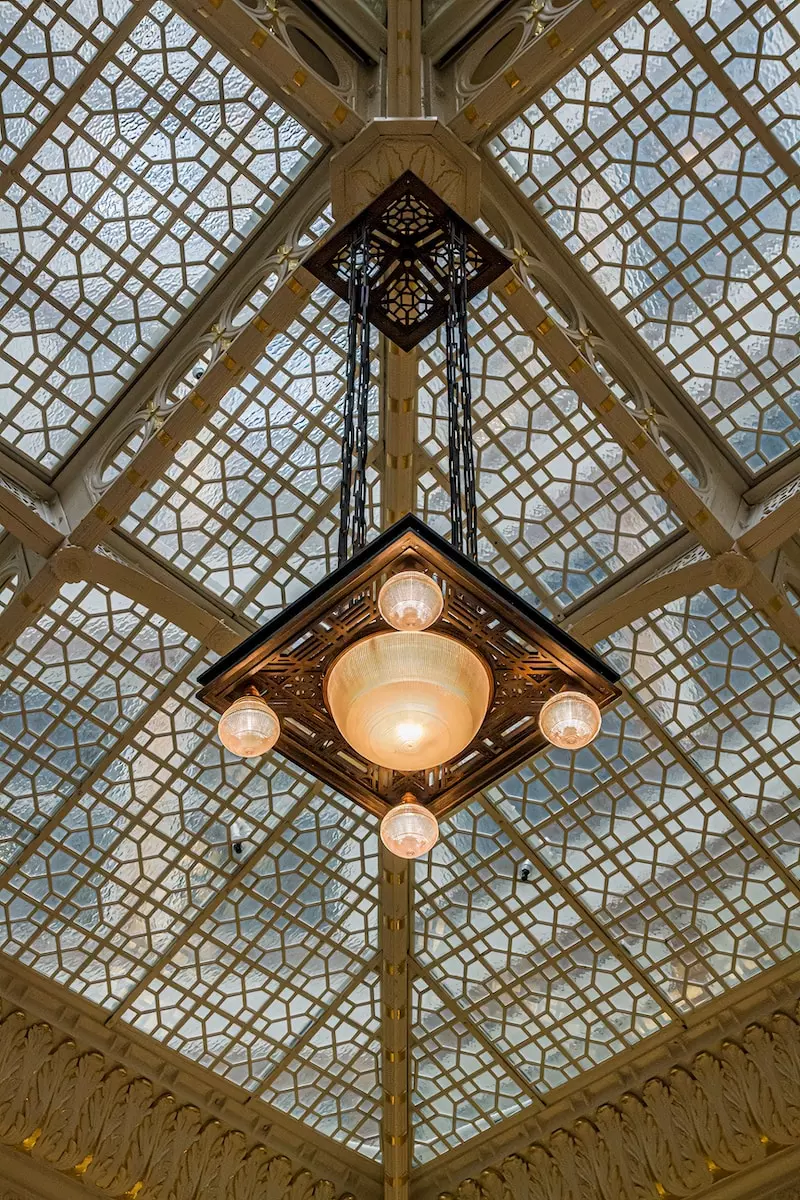Step into a world where clean lines meet organic forms, where simplicity blends seamlessly with nature, and where architecture becomes a work of art. In this article, we dive into the timeless elegance of Frank Lloyd Wright's interior design. Known for his innovative approach and visionary concepts, Wright revolutionized the field of architecture, leaving an indelible mark on the world of design. From his iconic Prairie style to his iconic Usonian homes, we explore the principles and elements that defined Wright's aesthetic, uncovering the enduring allure of his interiors. Join us on this journey as we unravel the genius behind Frank Lloyd Wright's designs and discover the lasting impact they continue to have on modern interior design.
 Frank Lloyd Wright's Guggenheim Museum Dome
Frank Lloyd Wright's Guggenheim Museum Dome
The Influence of Nature in Frank Lloyd Wright Interior Design
Frank Lloyd Wright's interior design style is heavily influenced by nature. He believed in creating spaces that harmonize with the natural environment, blurring the boundaries between indoor and outdoor. Wright incorporated natural elements such as light, water, and organic materials into his designs, bringing the beauty of the outdoors inside. By integrating nature into his interiors, Wright sought to create a sense of tranquility and connection to the natural world.
Uniting Form and Function: The Principles of Frank Lloyd Wright Interior Design
One of the key principles of Frank Lloyd Wright's interior design is the unity of form and function. Wright believed that a well-designed space should not only be aesthetically pleasing but also serve a practical purpose. He emphasized the importance of designing spaces that are efficient and functional, while still being visually appealing. This principle is evident in his use of open floor plans, built-in furniture, and innovative storage solutions. By prioritizing both form and function, Wright created interiors that are both beautiful and practical.
Organic Architecture: A Closer Look at Frank Lloyd Wright's Interior Design Philosophy
Frank Lloyd Wright's interior design philosophy is rooted in the concept of organic architecture. He believed that buildings and their interiors should be in harmony with their natural surroundings, reflecting the principles of nature. Wright sought to create spaces that are integrated into the landscape, using natural materials, open floor plans, and ample natural light. His interiors often feature flowing spaces, with a strong emphasis on horizontal lines and a seamless connection between indoor and outdoor spaces. By embracing organic architecture, Wright revolutionized interior design and created spaces that are both visually striking and in tune with the natural world.

The Use of Natural Materials in Frank Lloyd Wright Interior Design
One of the key aspects of Frank Lloyd Wright's interior design philosophy is the use of natural materials. Wright believed in integrating the built environment with nature, and this is reflected in his choice of materials. Wood, stone, and brick are commonly used in his designs to create a sense of warmth and connection to the natural world. These materials not only add visual interest but also provide a tactile experience, bringing a sense of harmony and authenticity to the space.
Spatial Harmony: Understanding the Flow of Frank Lloyd Wright's Interior Spaces
Frank Lloyd Wright was a master at creating spatial harmony in his interior designs. He believed that the flow of spaces should be seamless and intuitive, allowing occupants to move through the space with ease. Wright achieved this by carefully considering the placement of walls, doors, and windows to create a sense of openness and connection between rooms. His use of natural light and strategic positioning of furniture and fixtures further enhanced the sense of harmony, creating a cohesive and balanced interior environment.
The Legacy of Frank Lloyd Wright: Enduring Design Principles in Interior Design
The design principles used by Frank Lloyd Wright in his interior designs continue to influence the field of interior design today. His emphasis on the integration of nature, the use of natural materials, and the creation of spatial harmony are all concepts that are still valued and applied by contemporary designers. Wright's legacy not only lives on in his iconic buildings but also in the enduring principles that he championed, leaving a lasting impact on the world of interior design.

Incorporating Light and Shadow: Illumination Techniques in Frank Lloyd Wright Interior Design
Frank Lloyd Wright was a master at using light and shadow to create dynamic and dramatic interior spaces. His innovative approach to illumination techniques involved the strategic placement of windows, skylights, and light fixtures to maximize natural light and create a sense of openness. By carefully considering the orientation of a building and the movement of the sun throughout the day, Wright was able to harness the power of light to enhance the architectural features and materials used in his interior designs.
Integrating Nature and Technology: Frank Lloyd Wright's Approach to Modern Interior Design
Frank Lloyd Wright believed in harmonizing nature and technology in his interior designs. He saw the potential for technology to enhance the human experience and sought to integrate it seamlessly into his spaces. Wright often incorporated innovative materials and technologies, such as cantilevered structures and central heating systems, while also incorporating natural elements like stone, wood, and water features. This integration of nature and technology created a unique and modern aesthetic that is still admired today.
The Role of Geometric Patterns in Frank Lloyd Wright Interior Design
Geometric patterns played a significant role in Frank Lloyd Wright's interior design philosophy. He believed that geometric shapes and patterns had a harmonizing effect on the human mind and spirit. Wright often used geometric motifs in his furniture, textiles, and decorative elements to create a sense of unity and balance within a space. Whether it was through the repetition of squares, circles, or triangles, these geometric patterns added visual interest and a sense of structure to Wright's interior designs.

Creating a Sense of Tranquility: Frank Lloyd Wright's Use of Water Features in Interior Design
Frank Lloyd Wright was known for his innovative use of water features in his interior designs. He believed that water had a calming effect on the human mind and incorporated it into his spaces to create a sense of tranquility. Whether it was a small fountain or a larger waterfall, Wright carefully selected the location and design of these water features to enhance the overall atmosphere of his interiors.
Sustainable Design: Environmental Considerations in Frank Lloyd Wright Interior Design
Long before sustainability became a buzzword, Frank Lloyd Wright was incorporating environmental considerations into his interior designs. He believed in designing spaces that harmonized with nature and minimized their impact on the environment. From using local materials to implementing passive heating and cooling strategies, Wright's designs were ahead of their time in terms of sustainability and energy efficiency.
The Influence of Japanese Aesthetics on Frank Lloyd Wright's Interior Design
Japanese aesthetics had a profound influence on Frank Lloyd Wright's interior design philosophy. Inspired by the simplicity and harmony found in Japanese architecture, Wright incorporated elements such as clean lines, natural materials, and an emphasis on the connection between indoor and outdoor spaces. This influence can be seen in many of his iconic designs, creating a unique blend of Western and Eastern design principles.
Harmonizing Indoor and Outdoor Spaces: Frank Lloyd Wright's Seamless Interior Design
One of the defining features of Frank Lloyd Wright's interior design is his ability to seamlessly blend indoor and outdoor spaces. Wright believed that the connection between the built environment and nature was essential for creating harmonious living spaces. His designs often incorporated large windows, skylights, and open floor plans to bring in natural light and provide views of the surrounding landscape. By blurring the boundaries between inside and outside, Wright's interiors create a sense of unity with nature, allowing occupants to feel connected to the outdoors even when inside.
Textures and Materials: Exploring Frank Lloyd Wright's Interior Design Palette
Frank Lloyd Wright was known for his innovative use of textures and materials in his interior designs. He believed that the choice of materials should be dictated by the function and character of the space. Wright often used natural materials such as wood, stone, and brick, which he believed added warmth and a sense of organic beauty to his interiors. He also incorporated unique textures, such as textured glass, to create visual interest and play with light. The use of these materials and textures not only added depth and richness to Wright's interiors but also helped to create a sense of harmony and balance.
Embracing Simplicity: Minimalism in Frank Lloyd Wright Interior Design
Frank Lloyd Wright was a pioneer of minimalist design, emphasizing simplicity and functionality in his interior spaces. He believed that clutter and excess decoration detracted from the true beauty of a space. Wright's interiors often featured clean lines, open floor plans, and minimal ornamentation. By eliminating unnecessary details, the true essence of a space could shine through. This minimalist approach created a sense of calm and serenity in Wright's interiors, allowing occupants to focus on the essential elements of the space and experience a sense of tranquility.

Capturing Natural Light: Frank Lloyd Wright's Window Design in Interior Spaces
Frank Lloyd Wright was known for his innovative use of windows in his interior design. He believed that natural light was essential for creating a sense of well-being and connection to the outdoors. Wright's designs often featured large, strategically placed windows that allowed for ample natural light to enter the space. By harnessing the power of natural light, he was able to create interiors that felt bright, airy, and inviting.
Artistic Expression: Frank Lloyd Wright's Use of Murals and Wall Decor in Interior Design
Frank Lloyd Wright was not only an architect but also an artist. He believed in the importance of artistic expression in interior design. Wright often incorporated murals, wall decor, and other artistic elements into his designs to add visual interest and create a sense of uniqueness. By blending architecture and art, he was able to create interiors that were not only functional but also visually stunning.
Creating a Sense of Serenity: Frank Lloyd Wright's Interior Design for Meditation Spaces
Frank Lloyd Wright understood the importance of creating spaces that promote a sense of serenity and tranquility. He believed that architecture and interior design should support and enhance the spiritual experience. Wright's designs for meditation spaces often featured simple, clean lines, natural materials, and a connection to the natural surroundings. By creating spaces that fostered a sense of calm and introspection, he was able to create environments that were conducive to meditation and reflection.
In conclusion, the timeless elegance of Frank Lloyd Wright's interior design has had a profound impact on the world of architecture and continues to be relevant in the contemporary world. His innovative use of space, natural materials, and attention to detail have set a standard for interior design that is still admired and emulated today. Wright's ability to create harmonious and functional spaces that seamlessly blend with their surroundings has transformed the way we think about the built environment. His designs not only showcase his mastery of form and function but also reflect his belief in the importance of a harmonious relationship between humans and nature. As we continue to face challenges of sustainability and the need for environmentally conscious design, Wright's principles and philosophy remain as relevant as ever. The enduring legacy of Frank Lloyd Wright's interior design is a testament to the lasting impact of his vision and his ability to create spaces that transcend time and inspire generations to come.












